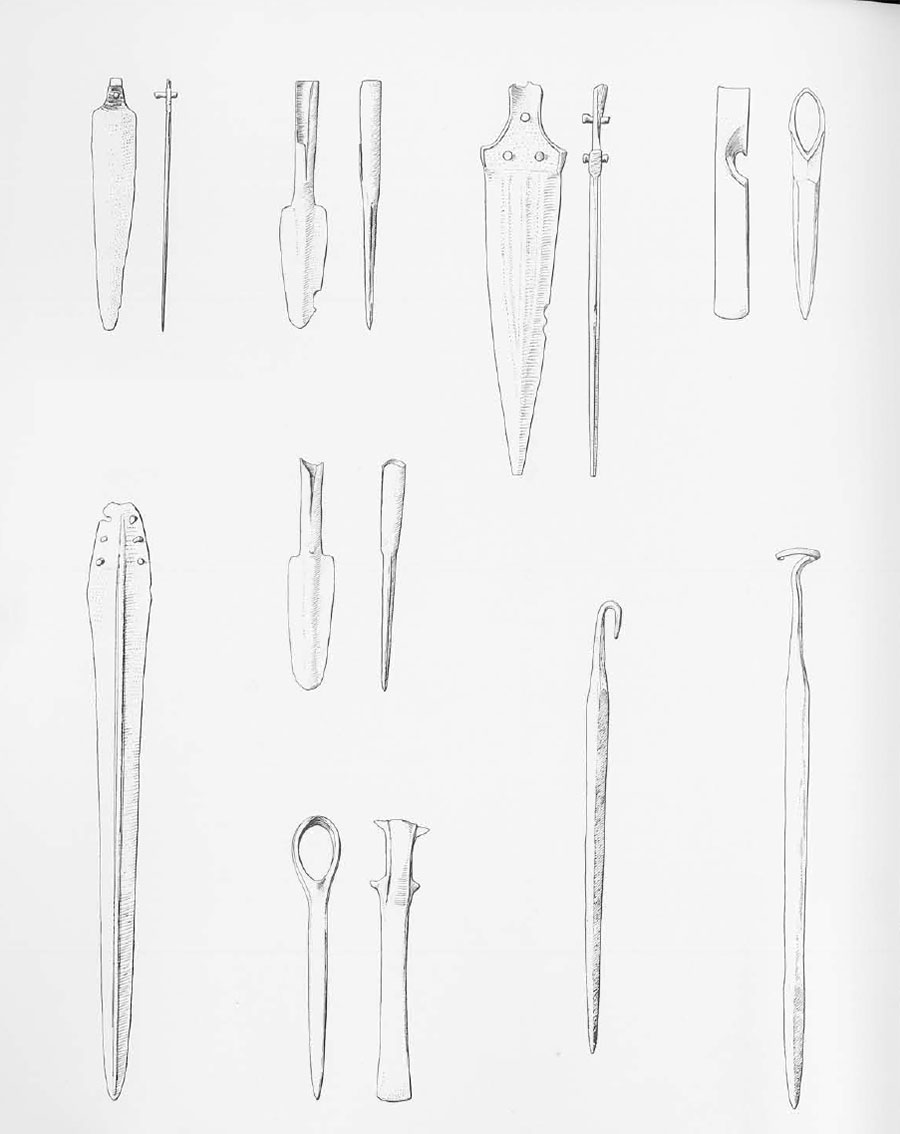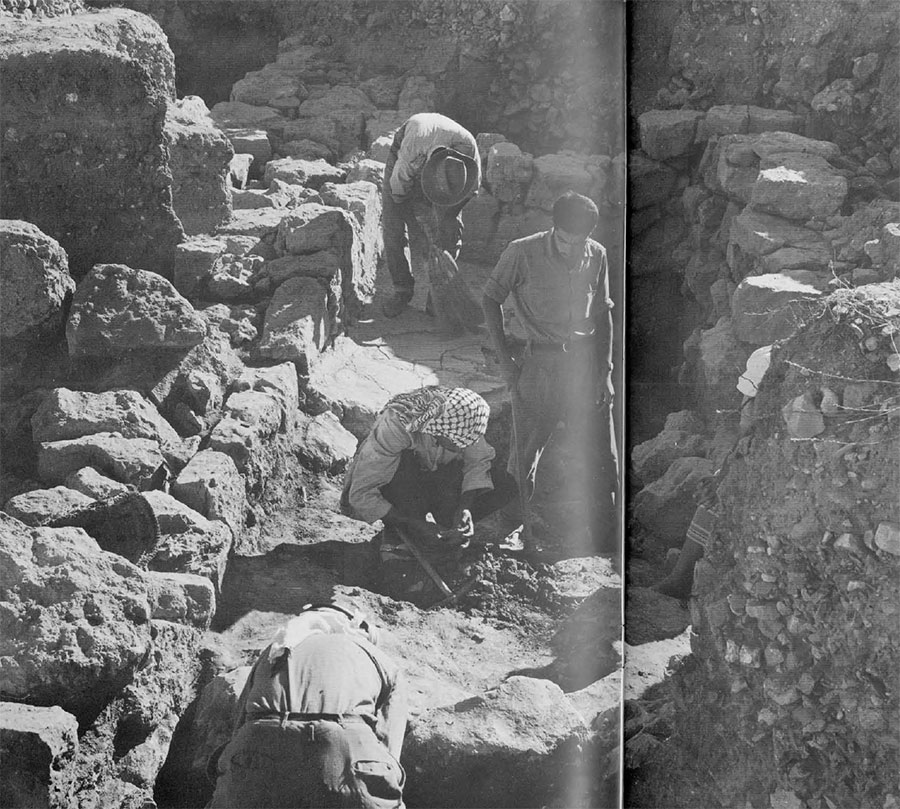
Defense was the most important single consideration in the planning and building of a city in Biblical Palestine, a land whose history is replete with accounts of destructive raids, invasions, and civil wars. In the five seasons of the Museum’s excavations at Gibeon we have found the defense of the city, which proved to be adequate for more than six centuries. The position of the city was naturally precarious, standing as it did beside one of the main routes from Jerusalem to the sea and near the uneasy border line which separated the northern Kingdom of Israel from its frequently hostile neighbor Judah. Yet by means of massive walls, strong towers, and ingenious devices for providing its citizens with water in time of siege, the Gibeonites managed to live securely. When one considers the measures which the builders of Gibeon took to provide their city with protection against their enemies, he can see not only intelligent planning but a willingness to pay heavily for civil defense. By far the greatest portion of public funds obviously went for security.
A city wall at Gibeon played an important part in one of the best known Biblical stories about the city, that of the sun standing still in Chapter 10 of the Book of Joshua. When a powerful coalition of five Amorite kings besieged Gibeon, the beleaguered inhabitants sent an urgen plea for help to Joshua, who responded by making a counter attack upon the Amorites. It is clear from the narrative in the Bible that the defenses of Gibeon proved adequate to keep the enemy out of the city until Joshua, aided by the miraculous grant of more daylight for fighting and by hailstones which fell upon the enemy, put to flight the forces of the five kings of the cities of Jerusalem, Hebron, Jarmuth, Lachish, and Eglon.
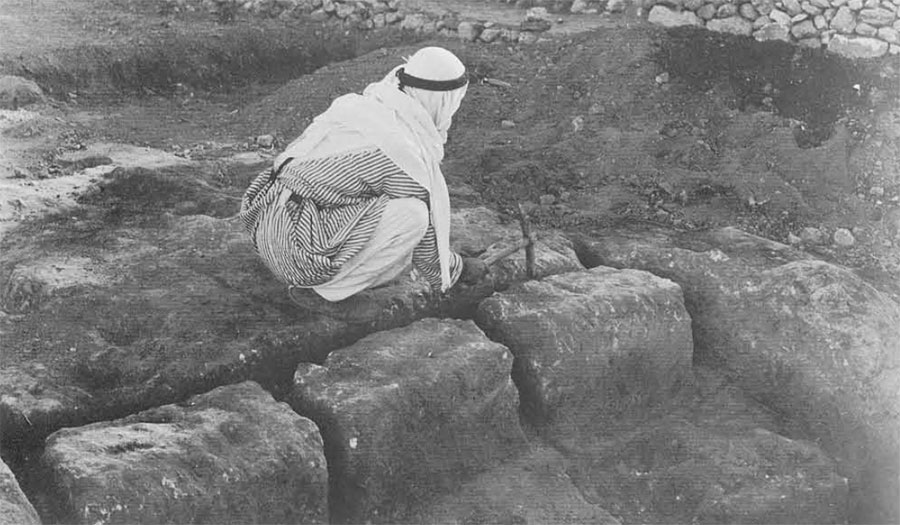
At the time of this celebrated siege, the city was protected by a wall five feet thick which encircled the natural hill on which the city was built. We do not know exactly how high this twelfth century wall stood, but to judge from the careful manner in which it was constructed of large, quarried stones, it could have towered to a height of three or more times its width. In addition to the fifteen feet or more of man-made masonry, there was the further defense provided by the natural rocky scarp of the hill which rises to more than two hundred feet above the level of the plain. To take the city, an enemy had not only to climb up this steep incline, but he had to breech the wall of solid masonry directly under defenders who could fight with heavy missiles of stone piled in readiness on the top of the rampart.
The city wall that served so well to protect the Gibeonites against the Amorites until the arrival of the army of Joshua had a relatively short life. After a little more than two centuries it was replaced by a better one. The occasion for the building of the newer defenses can only be conjectured. Possibly the appearance of a formidable foe and the fear of a new peril to the security of the city was the occasion for building the second wall; or perhaps the rise of a new ruler in Gibeon who was more adept at collecting taxes and impounding slave labor may have made possible this new defensive measure.
The second massive fortification, built early in the time of the divided monarchy, served to protect the city successfully for about four hundred years, for we have found no evidence for any destruction of the city which it surrounded until the destruction of about 600 B.C., when Gibeon fell, apparently during the campaigns of Nebuchadnezzar of Babylon, who pried loose some of the stones of the wall and hurled them down into the great pool in order to choke the water supply. The wall is ten feet thick and runs for a circumference of 3,150 feet, or approximately two-thirds of a mile. On the basis if a height which we were able to calculate roughly, it is possible to estimate that this fortification required the quarrying and removal of 80,000 tons of stone.
During the excavations of 1962 we found in one section of the wall clear evidence in the form of ancient foundation trenches, which could still be traced, for the method used in its construction. A line of a trench, slightly more than ten feet wide, had been marked out inside the earlier wall, the existing buildings demolished, and a gash ten feet deep had been cut to provide a firm foundation for the wall on the bedrock of the hill. Stones were hewn from the quarries on the side of the hill, dragged to the edge of the trench, and lowered into place to serve as a foundation for the rampart. When the trench had been completely filled with this structure of solid masonry and the wall had been built to slightly above-ground level, ramps of dirt were constructed at right angles to the wall, and the heavy building stones were pulled up the ramp to the height of the course for which they were intended. As the wall grew, the ramps were periodically rebuilt to provide an easy incline for moving the stones to the top of the rising city wall. Although these sloping ramps had been almost completely removed in the grading after the construction some thirty centuries ago, there remained traces of them at various intervals from the wall, that were easily distinguishable by the white line of stonemasons’ chips that had accumulated on the surface as the workmen were finishing the stones for the final fitting into the upper courses of the wall. By projecting these fragments of the original ramps in the direction of the city wall, we were able to estimate with a fair degree of accuracy the height of the wall, although the wall itself had been completely robbed of its stones except for the foundation.
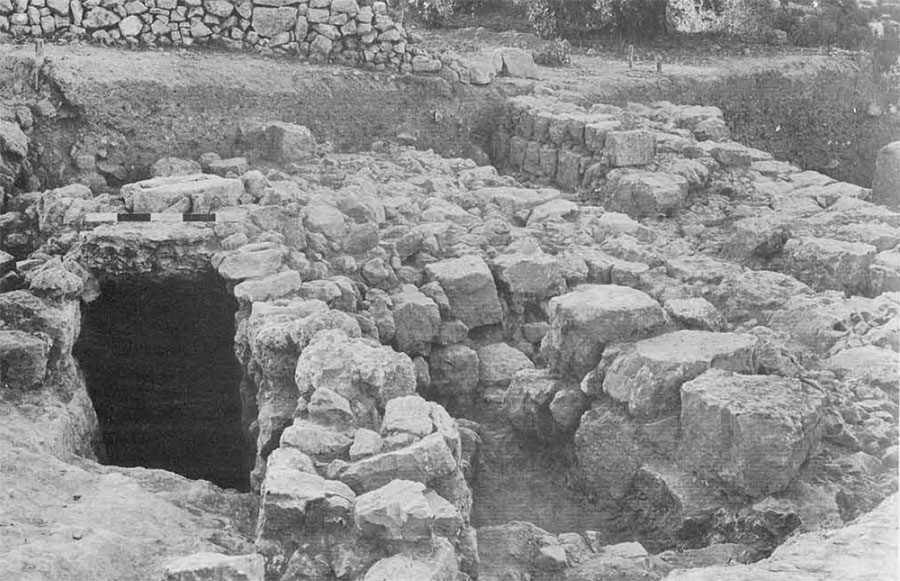
In our search laste season for tombs, that are generally to be found in layers of soft limestone which could be cut easily, we came upon a stone quarry which provided a good illustration of how building stones were removed–three building stones which had been partly cut away from the rock by deep trenches cut from the top. There remained only the final step in the removal, the breaking of the block free at the bottom, probably inserting wooden wedges in the grooves and wetting them with water to expand them sufficiently to sheer the stone loose from the bedrock.
Nowhere in Palestine has there survived from Biblical times a city wall with its upper courses intact. However, there is preserved in Egypt a good illustration of the appearance of the top of the city wall at Ashkelon. A boastful Egyptian king, Ramses II, decorated a wall at Karnak with a bas-relief that depicts his victories in the land of Canaan. In one scene there appear the people of Ashkelon standing behind a scalloped wall that was obviously for the purpose of providing protection for the fighters who defended the city. It is likely that the city wall at Gibeon was similarly finished off at the top with a balustrade to protect the men of the city from te arrows and javelins of the attackers.
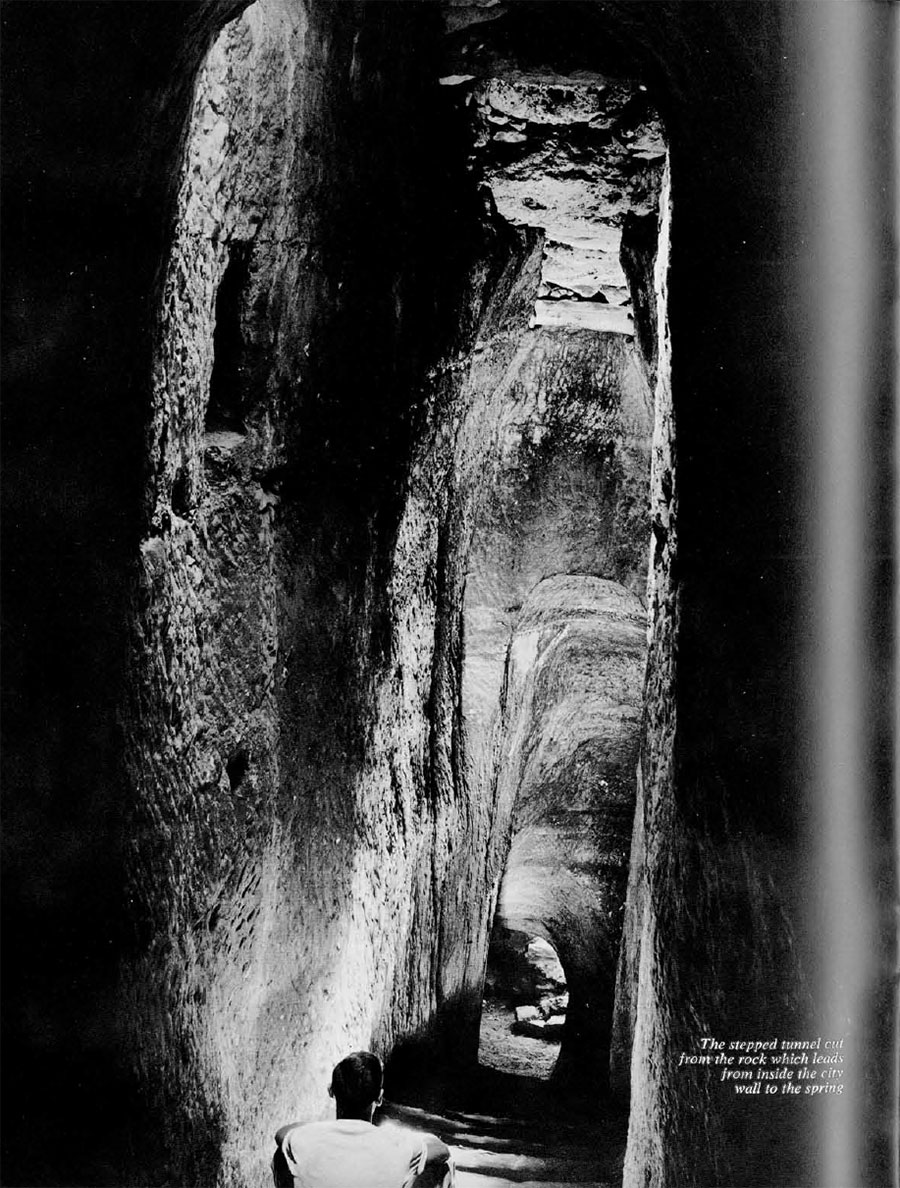
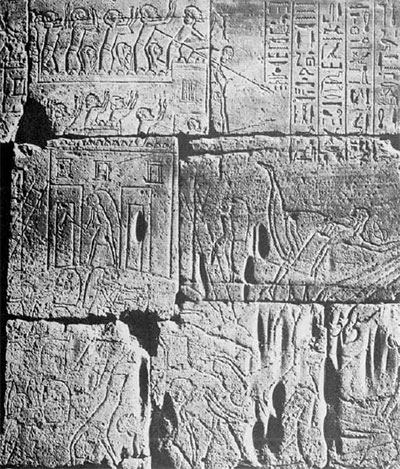
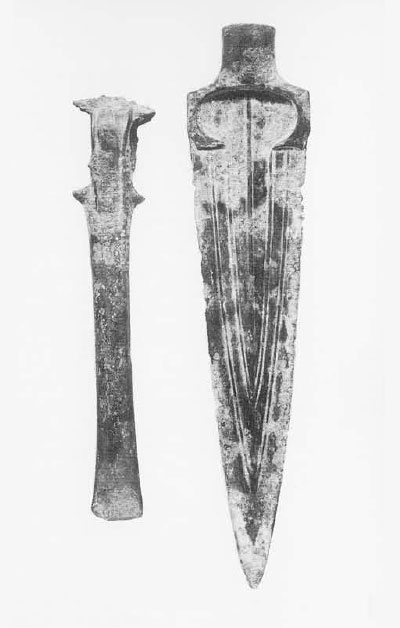
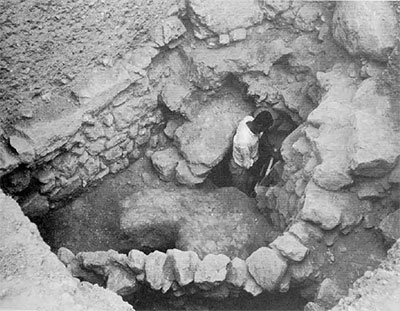
The Egyptian picture shows a tower in the city wall of Ashkelon. At Gibeon we found a double tower built into the wall at a strategic point just opposite the city’s water supply, by which the wall was enlarged to a width of 23 feet. From this point overlooking the road which runs from Jerusalem to the sea, a lookout could sound the alarm in the event of an attack or even the approach of hostile forces.
When the great city wall was first discovered we were puzzled by the absence of any system of drainage which would have allowed the rain water to escape from inside the city. Encircled as it was by a city wall without drains, the area of the walled city would, during the heavy winter rains, have become a large pool. Last season we found that the rain water which fell within the city was actually conserved. At the end of a city street leading from the top of the hill down to the city wall was a large rock-cut cistern, with a capacity of about 150,000 gallons, which had been used in the eighth and seventh centuries, and perhaps earlier, to catch the water which drained from the roofs of the houses which lined the street. To keep the dirt of the street from the cistern there was a filtering basin which served to purify the water before it flowed into the plastered cistern. The silt which we found to a depth of three to four feet in the settling basin when we discovered it in 1962 was an indication that it had been an effective device at the time of its last use at the end of the seventh century B.C. This installation provided a valuable water supply during the summer months; and at the same time the city wall did not have to be weakened by storm sewers which would have served as an easy access into the city from the outside.
In addition to the rain water collected in this manner, fresh spring water was made available within the city when the city gates were closed in time of siege. A tunnel was hewn from the solid rock of the hill from a point inside the city wall to a chamber on the edge of the hill where the water collected. In time of attack a doorway to the fhamber from the outside could be shut and the Gibeonites could go down the 93 steps of the tunnel in safety.
A more spectacular monument that remains to the effective defense system of the Gibeonites is the great pool, 80 feet deep and 37 feet in diameter, which was hewn from the rock within the limits of the walled city to provide an access to the water table deep within the hill this ambitious cutting may possibly be the “pool of Gibeon” mentioned in 2 Samuel 2:13 as the scene of the gruesome contest between the forces of Joab and those of Abner. By climbing down the 79 steps cut into the side of this pool, one may find today a copious supply of fresh water, just as the Gibeonites did in times of siege centuries ago.
The defenders of a walled city enjoyed a decided advantage over the attackers in that they could quickly thwart, bu the use of the simplest and most economical of weapons, any attempt to scale or to undermine the wall. :arge stones and even boulders could be dropped from the height of the wall upon the heads of the enemy. This method of defensive warfare is well-documented in two famous Biblical incidents. When Abimelech besieged the city of Thebez and approached the tower of the wall, “a certain woman threw an upper millstone upon Abimelech’s head and crushed his skull” (Judges 9:53). In a similar fashion Uriah, the husband of Bathsheba, met his death by approaching too close to the wall of Rabbah and finding himself within range of such ready missiles as loose stones and broken millstones (2 Samuel 11:20). The attackers, on the other hand, had to make use of arrows tipped with expensive bronze or iron, or javelins, which required even more of these costly metals.
Illustrations of how the Gibeonites defended themselves in hand-to-hand combat have come not from the city, but from the tombs of the warrior outside. In the course of the 1960 and the 1962 seasons we discovered and opened fifty Bronze Age tombs which have provided a fine assortment of weapons. There were no tools in the graves, but daggers and spear- and javelin-points appeared in great numbers. Weapons of offensive warfare, like arrowheads, have come generally from the area of the city proper, possibly from the positions in which they fell as they were shot over the walls by the enemies without.
Unlike many other cities in Palestine where there have been found numerous levels of ashes from the burnings that these cities have experienced in their histories, Gibeon bears no scars of destruction from the twelfth to the sixth century. This long span of peaceful life may have been due partly to the ability of these people to make treaties with their enemies, such as the famous covenant with Joshua, but certainly the elaborate system of city walls and the guarded water system were effective measures in providing for the civil defense of the city.
